Last Updated on October 6, 2024 by Kittredge Cherry
![]()
Historical records reveal a queer side to Saint Francis of Assisi, one of the most beloved religious figures of all time. The 13th-century friar is celebrated for loving animals, hugging lepers, embracing poverty and praying for peace, but few know about his love for another man and his gender nonconformity. His feast day is Oct. 4.
Francis is “a uniquely gender-bending historic figure” according to Franciscan scholar Kevin Elphick. His extravagant love crossed boundaries. Other Franciscan friars referred to Francis as “Mother” during his lifetime. He encouraged his friars to be mothers to each other when in hermitage together, and used other gender-challenging metaphors to describe the spiritual life.
He spoke of himself as a woman during his very first set of meetings with Pope Innocent III in 1210, when he was seeking permission to found a religious order. “I am that poor woman who in God’s mercy is loved and honored. God has begotten legitimate children through me,” Francis explained. The Pope was impressed by this gender-shifting argument and gave Francis his blessing to establish the new Franciscan order.
Francis experienced a vision of an all-female Trinity, who in turn saluted him as “Lady Poverty,” a title that he welcomed. Francis allowed a widow to enter the male-only cloister, naming her “Brother Jacoba.” His partner in ministry was a woman, Clare of Assisi, and he cut her hair in a man’s tonsured style when she joined his male-only religious order. She had a queer dream of drinking sweet milk from the breast of Francis. Clare consistently communicated that she sought to imitate Jesus, while Francis compared himself to Mary. Their cross-gender identification has been obscured for centuries in writing and artwork about them, but is reclaimed in the article “Imitatio Christi or Imitatio Mariae? Clare of Assisi and Her Interpreters” by Catherine Mooney in the book “Gendered Voices: Medieval Saints and Their Interpreters.”
He has been described as “a gay man’s man” who “deconstructed manhood.” When he chose voluntary poverty, it was also subversive and therefore queer.
Francis continues to have an enormous impact on church and society. He founded the Franciscan orders, which are among the largest and most influential Catholic orders. Pope Francis took him as his namesake in 2013, explaining that “Francis was a man of peace, a man of poverty, a man who loved and protected creation.” Francis personified medieval spirituality and yet was ahead of his time, described as “the first hero of humanism” by English author G. K. Chesterton in his acclaimed biography of the saint.
New in 2024: Artists show queer Francis of Assisi
Two new icons focusing on the queer Francis are added for his feast day on Oct. 4, 2024. Francis is portrayed as Lady Poverty, a genderbending title that he welcomed, in a 2023 image by the artist known as Faithful Heretic.
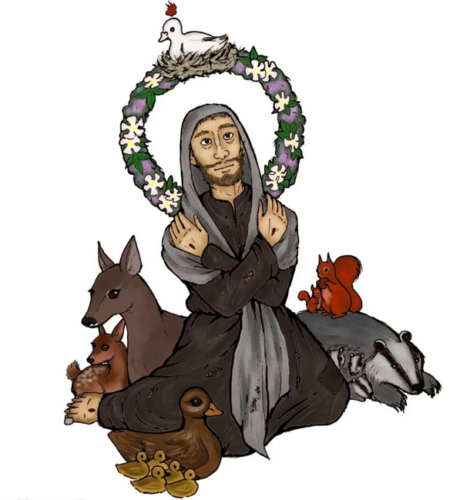
“Francis as Lady Poverty” by Faithful Heretic
The artist’s Instagram account described it as “recognizably an icon of St. Francis (barefoot scruffy guy with stigmata in a rough garment), but depicted with overtly feminine iconography. Baby ‘Snow White’ animals, a veil-like head covering, halo of wildflowers…. I hope it reminds viewers of the poor material conditions still experienced by many trans and gender-nonconforming people in the world today.” Raised Mormon, Faithful Heretic is an Episcopalian lay minister and a lifelong student of history, especially medieval history and LGBTQ history.

“St. Francis of Assisi: Day of Remembrance – October 4” by the nonbinary Russian group Snow Initiative
Doves hold a rainbow over Francis to indicate his queerness in an icon created by Snow Initiative (Инициатива СНеГ), a group by and for nonbinary people, based in St. Petersburg, Russia.
New in 2024: Francis and Sebastian meet in Renaissance art
Some Italian Renaissance artists paired Francis with another saint revered by today’s LGBTQ community: third-century martyr Sebastian. To 21st-century eyes, it is a wonderful surprise to see gender-nonconformist Francis next to Sebastian, patron saint of homosexuality. Even though they lived about a thousand years apart, they meet in the mystical space of a genre known as “sacra conversazione” (sacred conversation). What is the man who liked to be called Lady Poverty thinking as he exchanges glances with the near-naked martyr?
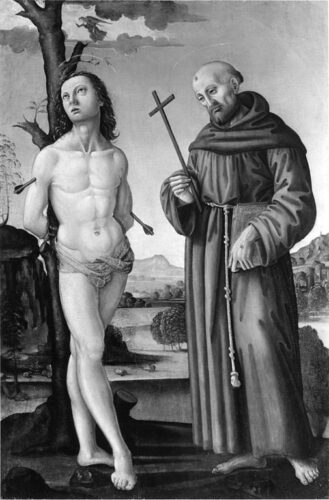
“Saint Sebastian and Saint Francis of Assisi” by Lorenzo di Credi, 1500-1510. (Wikipedia)
Art historians don’t seem to speculate on why Renaissance artists matched two of the most popular queer saints from different centuries, except to say that donors usually chose the saints in such paintings. A possible queer clue comes from the snail near Francis’ foot in a painting of them by Carlo Crivelli. Snails were thought to symbolize the virgin birth because of their asexual / hermaphroditic methods of reproduction.
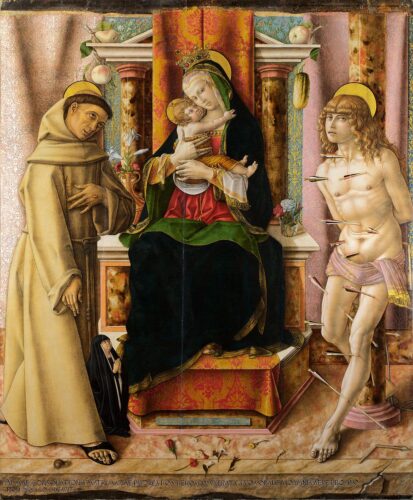
“The Virgin and Child with Saints Francis and Sebastian” by Carlo Crivelli, 1491. (Wikipedia)
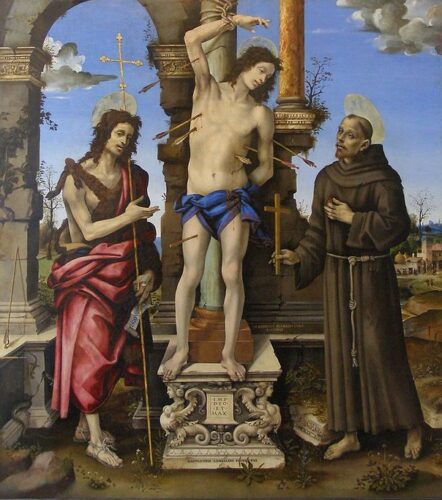
“Saint Sebastian between Saints John the Baptist and Francis” by Filippino Lippi, 1502. (Wikipedia)
Francis embraced outcasts and nature
Francis was born to a wealthy family in late 1181 or early 1182 in the Italian town of Assisi. His father was a prosperous silk merchant. As a young man, Francis renounced his wealth, literally stripping himself naked, and devoted himself to a life of poverty in the service of Christ.
He connected with nature, calling all animals “brother” and “sister” and celebrating them in his famous Canticle of the Sun. Animal blessing events happen all over the world in October for the Feast of St. Francis, the patron saint of animals. Q Spirit celebrates by offering an animal blessing prayer by Q Spirit founder Kittredge Cherry and portraits of animal companions.
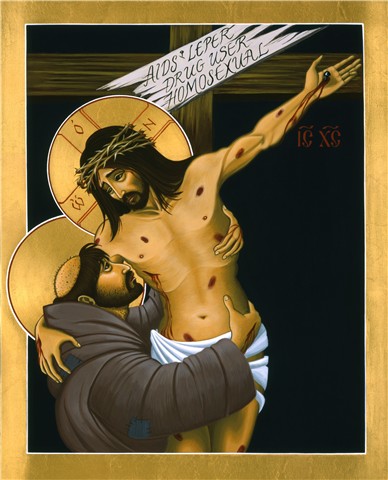
“St. Francis ‘Neath the Bitter Tree” by © William Hart McNichols
He saw the face of Christ in lepers, the most reviled outcasts of his time, and nursed them with compassion. William Hart McNichols puts Francis’ ministry into a contemporary context by showing him embracing a gay Jesus with AIDS in “St. Francis ‘Neath the Bitter Tree,” pictured here. Words on the cross proclaim that Christ is an “AIDS leper” as well as a “drug user” and “homosexual,” outcast groups at high risk for getting AIDS. The two men gaze intently at each other with unspeakable love as Francis hugs the wounded Christ. It was commissioned in 1991 by a New Jersey doctor who worked with AIDS patients, and is discussed in the book Art That Dares: Gay Jesus, Woman Christ, and More by Kittredge Cherry.
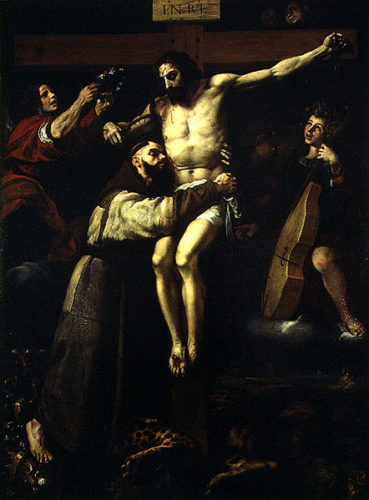
“Saint Francis Embracing Christ” by Francisco Ribalta (Wikimedia Commons)
McNichols created the icon in his own style based on a 1668 painting by Spanish painter Bartolome Esteban Murillo, which was surely inspired by the more passionate 1620 version of fellow Spaniard Francisco Ribalta. In Ribalta’s work, Christ responds to St. Francis’ ecstatic kiss by giving the saint his crown of thorns, the symbol of suffering that leads to divine union.

Francis embraces and gazes up at Jesus in “Jesus with Francis after Murillo” by Eureka Artist, also known as Michael O’Hanlon
Michael O’Hanlon, an Australian artist and queer activist, was inspired to create a work based on the Murillo painting when he saw it at the Seville Museum during a 2018 artist’s residency in Spain. He photographed two Sevillano men in the same intense embrace.
Francis dearly loved his male companion
When Francis (1181-1226) was a young man, he had an unnamed male companion whom he dearly loved — and who was written out of history after the first biography. Elphick has spent years researching the queer side of Saint Francis, including travel to his hometown of Assisi. There he photographed artwork depicting the man he believes may have been the saint’s beloved soulmate: Brother Elias of Cortona.
Francis of Assisi and the man he loved in “They Shelter in a Cave” by José Benlliure y Gil, 1926 (Wikimedia Commons)
The earliest companion of Francis, a man whom Francis “loved more than any other because he was the same age” and because of “the great familiarity of their mutual affection” remains nameless. Elphick’s research suggests that the unnamed soulmate of Saint Francis was Brother Elias of Cortona.
Francis called Elias “Mother” and gave him a special blessing. Elias expressed much concern about Francis’ body and his health. Francis and Elias each describe the other in affectionate terms. However, very quickly after Francis died, Elias is written out of history and discredited. Elphick presents the scholarly evidence about their relationship in the detailed article at the Jesus in Love Blog: “Brother Elias: Soulmate to Saint Francis of Assisi?”
Early evidence of the various ways that Francis crossed gender boundaries are gathered in the ground-breaking unpublished master’s thesis “Gender Liminality in the Franciscan Sources” by Elphick, who is both a Franciscan scholar and a supervisor on a suicide prevention hotline in New York. He wrote the thesis for a master’s degree in Franciscan studies from St. Bonaventure University in New York.
 Francis’ love for another man is described in his earliest biography, The First Life of St Francis of Assisi
Francis’ love for another man is described in his earliest biography, The First Life of St Francis of Assisi by Thomas of Celano, a follower of Francis who knew him personally. The biography was completed by 1230, just four years after Francis died. Celano says that when Francis was in his 20s, before embracing a life of poverty, he dearly loved a special male friend:
“Now there was a man in the city of Assisi whom Francis loved more than any other, and since they were of the same age and their constant association and ties of affection emboldened Francis to share his secret with him, he would often take this friend off to secluded spots where they could discuss private matters and tell him that he had chanced upon a great and precious treasure. His friend was delighted and, intrigued by what he had heard, he gladly accompanied Francis wherever he asked. There was a cave near Assisi where the two friends often went to talk about this treasure.”
In his thesis, Elphick points out, “Because homosexuality and ‘gay’ identities are modern constructs, it is impossible and inaccurate to attempt to read these modern categories into the personalities of historical figures.” Instead he uses the word “homoaffectional” to describe the relationship of Francis and his beloved companion.

Brother Elias (center) at the Baptismal font where St. Francis was christened in the Cathedral of San Rufino in Assisi, Italy. (Photo by Kevin Elphick)
“The relationship is inescapably homoaffectional, describing a shared intimacy between two Medieval men. That this first companion disappears from the later tradition is cause for suspicion and further inquiry…. The tone in Celano’s earliest account captures the flavor and intimacy of this relationship, perhaps too much so for an increasingly homophobic church and society.”
Francis and his beloved friend are seldom depicted by artists, but they are shown together in a rare and hard-to-find image: “They shelter in a cave” (Se cobijan en una cueva) by Spanish painter José Benlliure y Gil. It is the 8th in his series of 74 images from the life of Saint Francis. The series was published by Franciscans in Valencia, Spain, in 1926 in a book to mark the 700th anniversary of the saint’s death. A commentary in Spanish about the picture is available online.
Elphick finds many more examples of what he calls “gender liminality” in historical documents on Francis. He defines liminality as “crossing the threshold of gender, either symbolically, or by actions within a person’s life that breach the social boundaries of gender.”
Francis and the all-female Trinity: “Three women appeared”
Francis rejoiced when an all-female Trinity greeted him as “Lady Poverty” in a queer experience that has been ignored, sanitized and perhaps suppressed for centuries, even though it is “hiding in plain sight” in the earliest source and in at least one famous altarpiece:.
The 13th-century friar’s little-known encounter disrupts and reverses traditional distinctions of gender and social class. For Francis, such earthly restrictions cannot limit God.
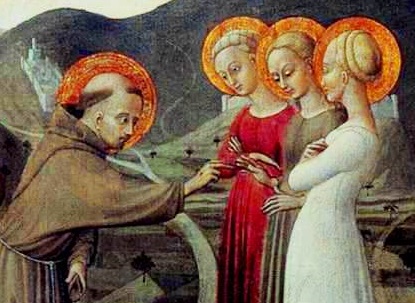
Detail of Saint Francis with female Trinity by Sassetta… better known as “The Marriage of Saint Francis with Lady Poverty” (Wikipedia)
Christian doctrine says that there is one God in three persons: “Father, Son and Holy Spirit.” Francis saw this Holy Trinity embodied instead as “three poor women.” Does that make them Mother God, Christa and the Holy Spirit? Church authorities sometimes allow the Holy Spirit to be represented as female, but never the entire Trinity — except this time.
Disregarding his biological sex, the women call Francis himself “Lady Poverty” — and he loves it! The genderbending name honors his commitment to upend social hierarchies and embrace poverty as a spiritual path.
Later writers and artists downgraded the identity of the three women. Instead of embodying the Holy Trinity, they were said to represent the virtues of poverty, chastity and obedience. Lady Poverty ceased to be a name for Francis, and was recast as his bride in a mystical marriage.
Take a close look at the 15th-century painting by Italian Renaissance artist Stefano di Giovanni di Consolo, who is known as Sassetta.
Many usually reliable websites display this painting with titles such as “The Marriage of Saint Francis to Lady Poverty” or “The Mystical Marriage of Saint Francis.” Mystical, yes. But what makes them think this is a marriage? And how did the identity of Lady Poverty switch from Francis himself to one of the women? The dominance of heterosexual marriage and gender conformity must have been too powerful to resist. However, the painting matches the original story much better than the marriage model.
The painting is labeled as the mystical marriage of Francis with Lady Poverty, but a close examination shows that it illustrates the story of Francis and the female Trinity. He is not marrying Lady Poverty — he IS Lady Poverty! Later the same female Trinity floats over the ecstatic Francis in the altar’s climactic central image.
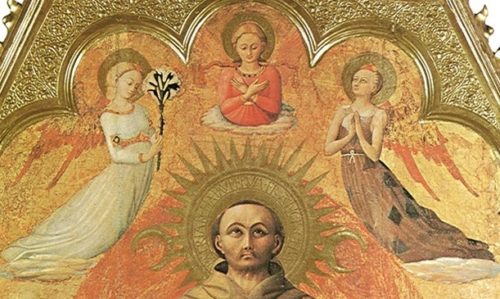
A female Trinity appears in “Saint Francis in Ecstasy” by Sassetta. (Wikipedia)
 The story of Francis’ encounter with the female Trinity is recorded in chapter LX of “The Remembrance of the Desire of a Soul,” one volume in the Francis trilogy. It was written within two years of Francis’ death in 1226 by Thomas of Celano, a contemporary of Francis and his earliest biographer. Here is the text, as translated by Regis Armstrong:
The story of Francis’ encounter with the female Trinity is recorded in chapter LX of “The Remembrance of the Desire of a Soul,” one volume in the Francis trilogy. It was written within two years of Francis’ death in 1226 by Thomas of Celano, a contemporary of Francis and his earliest biographer. Here is the text, as translated by Regis Armstrong:
Chapter LX: How three women appeared to him on the road, and how they disappeared after a novel greeting
I will tell in a few words something marvelous, doubtful in interpretation, most certain in truth. When Francis, the poor man of Christ, was traveling from Rieti to Siena for the treatment of his eyes, he passed through the plain near Rocca Campiglia, taking as a companion on the journey a doctor who was very devoted to the Order. Three poor women appeared by the road as Saint Francis was passing. They were so similar in stature, age, and face that you would think they were a three-part piece of matter, modeled by one form. As Saint Francis approached, they reverently bowed their heads, and hailed him with a new greeting, saying: “Welcome, Lady Poverty!” At once the saint was filled with unspeakable joy, for he had in himself nothing that he would so gladly have people hail as what these women had chosen. And since he thought at first that they really were poor women, he turned to the doctor who was accompanying him, and said: “I beg you, for God’s sake, give, something to these poor women.” The doctor immediately took out some coins, and leaping from his horse he gave some to each of them. They then went on for a short way, and suddenly the doctor and the brothers glanced back and saw no women at all on that whole plain. They were utterly amazed and counted the event as a marvel of the Lord, knowing these were not women who had flown away faster than birds.
 Who are these three supernatural women? Early Franciscan writer Saint Bonaventure (1221-1274) wrote in his Life of Saint Francis that this triple goddess symbolized the three virtues of charity, obedience and poverty. His interpretation gained broad acceptance.
Who are these three supernatural women? Early Franciscan writer Saint Bonaventure (1221-1274) wrote in his Life of Saint Francis that this triple goddess symbolized the three virtues of charity, obedience and poverty. His interpretation gained broad acceptance.
Kevin Elphick, a scholar specializing in queer Franciscan subjects, explains in a recent article how “the language describing the three women is inescapably Trinitarian in formula.” He presents full evidence for the Trinitarian understanding in his article “Thee Poor Women Appeared” in the winter 2016 issue of “Franciscan Connections: A Spiritual Review.”
The description of them as “a three-part piece of matter, modeled by one form,” closely resembles Christian creeds that proclaim the Trinity as three distinct persons of one substance. He points out how the appearance of the three women also echoes the story in Genesis of how Abraham and Sarah welcomed three mysterious visitors. They are interpreted in Christian tradition as the three persons of the Holy Trinity.
Of course, all this mislabeling makes it virtually impossible for researchers to find the beautiful paintings of Francis with the female Trinity… despite the fact that art prints are widely available for both the “marriage” and the ecstasy of Francis.
Francis embraced a Muslim sultan
Late in his life Francis embodied his commitment to peace through man-to-man Christian-Muslim dialogue in the Mideast, a region where people are still at war.
In 1219 Francis went to Damietta, Egypt, with the European armies during the Fifth Crusade. He hoped to discuss religion peacefully with the Muslims. He tried to prevent Crusaders from attacking Muslims at the Battle of Damietta, but he failed. Francis was captured and taken to the sultan Malek al-Kamil. At first they tried to convert each other, but each man soon recognized that the other already knew and loved God. They remained together, discussing spirituality, for about three weeks between Sept. 1 and Sept. 26.
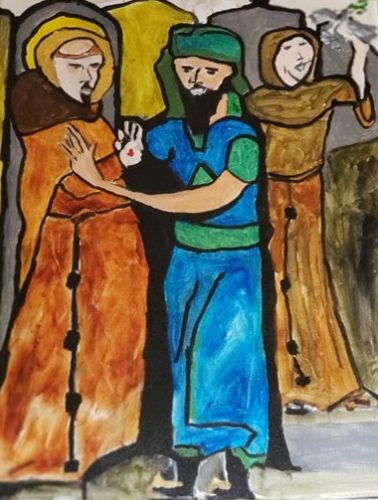
“Francis Meets the Sultan of Egypt” by JR Leveroni
Florida artist JR Leveroni of Evolved Art painted Francis meeting the sultan in a colorful modern style that he calls “evolved Impressionism.” The third man in the painting is Francis’ travelling companion, a friar named Illuminatus. They travelled together, just the two of them. Leveroni specializes in painting religious themes, sometimes exploring themes of same-sex love.
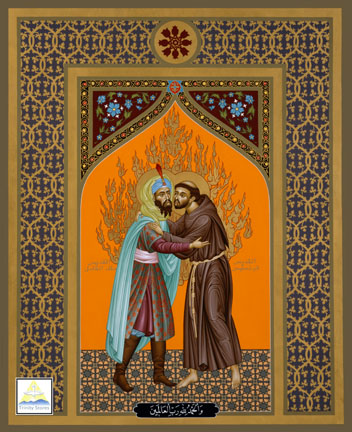
“St. Francis and the Sultan” by Robert Lentz. Prints available at Trinity Stores.
Their meeting is celebrated as a model of interfaith dialogue in the icon “St. Francis and the Sultan” by Robert Lentz, a Franciscan friar known for his innovative and LGBTQ-positive icons. He is stationed at Holy Name College in Silver Spring, Maryland. Lentz discussed the icon in a video.
Francis received the stigmata
In 1224, when Francis was in his 40s, he received the stigmata — marks like the crucifixion wounds of Christ in his hands, feet and side. Stigmata is the plural of stigma, which also means disgrace in English. Francis warmly welcomed society’s stigmatized outcasts and stood with them. California artist Kevin Raye Larson emphasizes the sensuality of the ecstatic moment in “St Francis of Assisi Receiving the Stigmata.” The painting has appeared on the cover of the spirituality issue of “Frontiers,” the Los Angeles gay lifestyle magazine. It takes artistic liberties with the facts by showing Francis receiving the stigmata as a young man, stripped naked to symbolize how he renounced his inheritance.
 |
| “St Francis of Assisi Receiving the Stigmata” by Kevin Raye Larson © 1991 |
Along with the stigmata came health problems. When Francis sensed death approaching, he called for Jacoba de Settesoli, a Roman noblewoman devoted to him and his teachings. Francis stayed in her house when in Rome. Celano’s 13th-century account in the “Treatise on the Miracles of Blessed Francis” reports that Francis greeted the news of her arrival at the male-only cloister with a decidedly queer statement that breaks gender rules::
“Blessed be God, who has guided the Lady Jacoba, our brother, to us. Open the door and bring her in, for our Brother Jacoba does not have to observe the decree against women.”
Francis died a few days later on Oct. 3, 1226 at about age 45. Two years after Francis’ death, Pope Gregory IX declared him a saint and commissioned Celano’s biography, the one that includes the love between Francis and his male companion. Francis is venerated by Catholic, Episcopal, Anglican and Lutheran churches, but not in the Orthodox tradition. He was canonized less than 200 years after the Great Schism between Roman Catholic and Eastern Orthodox church in 1054, and his belief in the supremacy of the Pope is a considered a heresy by the Orthodox.
Elphick adds an intriguing footnote about how the queer side of Francis has manifested outside official Christianity. Francis is syncretized and venerated in the Yoruba religion of Africa as Orula or Orunmila, the orisha of wisdom, patron of animals and a transgender deity who engages in same-sex eroticism.
Rainbow visions evoke the queer Francis of Assisi
Artists and writers sometimes use rainbows to express the queer side of Francis.
“Saint Francis Preaching to the Birds” by Matthew of Queer Catholic Icons appears at the top of this post. Doves hover on each side of Francis against a rainbow background that affirms his queerness. The icon was created by Matthew, a practicing Roman Catholic who shares his artwork at Queer Catholic Icons on Instagram as @queer.catholic.icons. For the fashionista of faith, rainbow Francis tote bags are available with the image from the Queer Catholic Icons Etsy shop.
Francis felt such a strong kinship with nature that he preached to a flock of birds, addressing them as “my little sisters.” The birds listened attentively and responded to his final blessing by singing sweetly as they flew away in a cross formation. The story of his sermon to the birds is told in the late 15th-century hagiography “The Little Flowers of St. Francis of Assisi.”
Francis has a rainbow over his shoulders to affirm his queer affinities in the 2022 linocut block print “Lord, Make Me an Instrument of Your Inclusion” by Tony O’Connell. “His rainbow represents his inclusiveness, gender defiance and tolerance of all suffering beings regardless of status or even species,” O’Connell said. He sees Francis is not just as saint, but “a gender non-compliant queer spiritual archetype who can be reclaimed and celebrated by marginalised minorities.”
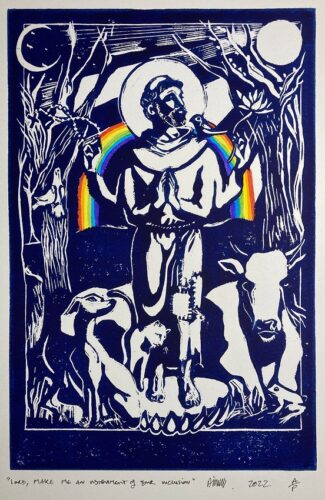
“Lord, Make Me an Instrument of Your Inclusion” by Tony O’Connell. Limited-edition hand-tinted linocut prints signed by the artist are available at his Hallowed Prints shop on Etsy.
Surrounded by animals, his rainbow Francis prays so powerfully that his Rosary flies outward like an infinity sign. He holds a crucifix in one hand and a lotus in the other, balancing Christian and Buddhist spiritual traditions in his wounded hands. Christ rising from the grave parallels the Buddhist symbol of a pure lotus rising out of the mud. Meanwhile he keeps his other pair of hands folded in prayer, palms together. It may take time for viewers to notice that this Francis has four arms — a Buddhist artistic convention to show that a being has many powers. O’Connell’s of queer saints appear frequently on Q Spirit and are available at his Hallowed Prints Etsy shop. The trees behind Francis are somewhat similar to his print of Our Lady of Montevergine rescuing a queer couple, so his Francis could be a companion piece for that.
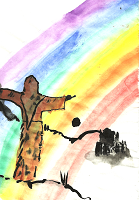
Rainbow Francis by Pat Groves
Based in Liverpool, O’Connell was raised in the Roman Catholic church, but has been a practicing Buddhist since 1995. “I’m convinced that Francis was a very realized Bodhisattva,” O’Connell told Q Spirit, using the Buddhist term for an enlightened person who delays going to nirvana (heaven) out of compassion to save others from suffering. In transcending gender, Francis is like the bodhisattva Avalokiteshvara or Kuan Yin, who appears with whatever gender is necessary to help people in need.
O’Connell titled his work “Lord, Make Me an Instrument of Your Inclusion” in honor of the late Franciscan friar Pat Groves, who wrote the line when he adapted the famous peace prayer that is often attributed to Francis. The standard version begins, “Lord, make me an instrument of your peace.” Groves changed it to “Lord, make me an instrument of your inclusion” in the “Rainbow Prayer of Saint Francis,” which he posted on the Pride page of his website. Evidence suggests that Francis did not actually write the peace prayer himself. It first appeared anonymously in a small French Catholic magazine in 1912. The rainbow version includes these lines:
Where there is bigotry,
let me sow understanding….
Grant that I may not
so much deny who I am
as affirm and empower myself;
not so much question my sexuality
as be challenged by it;
not so much be content with my orientation
as to become enlivened by it.
For it is in coming-out
that we become ourselves …
Groves painted Francis with his arms spread wide to welcome a rainbow. Groves died in 2020 at age 73 at Old Mission San Luis Rey in California. Since then his LGBTQ-affirming work has become difficult to find, but his rainbow Francis painting is posted online at New Ways Ministry.
Francis of Assisi still brings queer inspiration
“The Queerness of St. Francis of Assisi,” a 17-minute video, was released on YouTube in 2023 by Avery Arden, who runs the Blessed are the Binary Breakers website and podcast. Based in Atlanta, Georgia, Arden is a genderqueer Catholic-Presbyterian graduate of Louisville Seminary in Kentucky. The video compiles their TikTok videos exploring Francis through a queer lens. “A great deal of the info shared in this video comes from Kittredge Cherry’s QSpirit article on Francis,” Arden said in a Facebook announcement of the video.
At the end of his thesis, Elphick concludes that breaking gender rules is an extraordinary God-given power or “charism” that Franciscans offer to the church and the world.
“What are the lives of figures like Mother Francis, Brother Jacoba and Mother Juana de la Cruz revealing to us in our own day? I think that the Franciscan charism of gender liminality has much to teach our Church and fellow community of humans in our day. In a church divided over issues of ordination of women, inclusive language, and sexual orientation, I believe that the Franciscan tradition has important figures to hold up and from whom to learn. For issues which we have not even yet begun to explore theologically in authentic ways, issues such as hermaphroditism, transsexuality, genderedness and sexual orientation, I believe the Franciscan voice can be prophetic.”
Scholar Tyrone Grima of Malta presented a paper titled “Queering Francis” at the Conference on Queer and Transgender Studies in Religion at the University of California Riverside in February 2022. The paper looks at LGBTQ themes in the life of Francis and analyzes the theatrical performance “Queering Francis,” which was presented at in a Jesuit retreat house in Malta in January 2022. The audience was composed mostly of members of Drachma LGBT, a group founded by Grima to integrate sexuality and spirituality.
Poet explores love between Francis and Jesus
Poet Jim Wise explores the love between Francis and Jesus with a touch of homoeroticism in his poem “Stigmata.”
He describes himself as “Queer Poet, Hermetic Mendicant, and Pantheist, itinerant theologist and roving Chaote – an Earth-centered, Eros-loving, Logos-chasing, dirt-worshiping revolutionary – living in the American Midwest.” He considers himself “something of a UCC Old Catholic spiritual pilgrim” because he attended seminary under sponsorship of the United Church of Christ and was ordained in an Old Catholic jurisdiction. The following poem comes from his “Queer Psalter” collection, currently a work in progress. Wise’s poetry has appeared in RFD Journal, The Gay and Lesbian Review Worldwide, and a host of online literary journals and zines.
Stigmata
By Jim Wise
Pierced by Christ,
the great penetration
only a God can give.
Assisi boy Francis
was the first, you know.
Out of all the pious faithful,
out of all the priests and
monks and friars and
whispering mystics who
cruised Christ down
the centuries, it took a
beggar boy dressed out
in a rough habit, singing
songs to the sun and moon
to catch the Messiah’s eye.
Francesco,
Saint Francis,
the beloved of the Lover
who was Love Itself
in human form.
Christ loves everyone.
So we’re told and
so we believe but
the stigmata is proof
that Christ, like most
of us, has a type.
He may love everyone
but his sacred lust is
reserved for barefoot
hippie boys who live
life wild and free,
who don’t clutter their
brief lives with things
and stuff and junk,
who always keep a
backpack near the
door just in case
the spirit moves.
Christ goes for those
careless guys who rent
apartments instead of
buy big houses with
thirty year loans,
who drive beat-up old
junkers or second-hand
jeeps or who take the
bus when they need
to go downtown, who
let their hair grow out
and give their stubble
permission to go wild,
who never waste a minute
worrying about whether
or not they have enough
in their retirement fund
to get them through life
and safely in the ground.
I’ll bet Christ loved
Berkeley back in the day,
and I have to wonder.
If I drove down to Asheville
on the hottest day of summer,
would I see a group of
barefoot hippie boys with
bleeding hands and feet?
For the feast of Saint Francis: Get a pet portrait
Get a pet portrait of your dog or cat! Artist Trudie Barreras has renewed her pet-portrait offer for the Feast of Saint Francis of Assisi, patron saint of animals.
She will make a pastel drawing of your animal companion for a $25 donation to the Q Spirit / Jesus in Love project on LGBTQ spirituality. Click here for more info.
Links related to Francis of Assisi
“Brother Elias: Soulmate to Saint Francis of Assisi?” by Kevin Elphick (Jesus in Love)
“Queering Francis” by Tyrone Grima (Interalia: A Journal of Queer Studies)
St. Francis of Assisi: A Gay Man’s Man (The Wild Reed)
“The Queerest Catholic Saint? Francis of Assisi deconstructed manhood—and changed the world” by Jonathan Poletti (Medium.com)
Rainbow Christ Prayer in Italian: La Preghiera del Cristo Arcobaleno
To read this post in Spanish / en español, go to Santos Queer:
San Francisco de Asís: La evidencia histórica revela su lado gay
___
Top image credit:
“Saint Francis Preaching to the Birds” by Matthew of Queer Catholic Icons (@queer.catholic.icons on Instagram)
___
This post is part of the LGBTQ Saints series by Kittredge Cherry. Traditional and alternative saints, people in the Bible, LGBTQ martyrs, authors, theologians, religious leaders, artists, deities and other figures of special interest to lesbian, gay, bisexual and transgender and queer (LGBTQ) people and our allies are covered.
This article has evolved and expanded greatly since the first version was posted in October 2010. It was published on Q Spirit in October 2017, was enhanced with new material over time, and was most recently updated on Oct. 6, 2024.
Copyright © Kittredge Cherry. All rights reserved.
Qspirit.net presents the Jesus in Love Blog on LGBTQ spirituality.

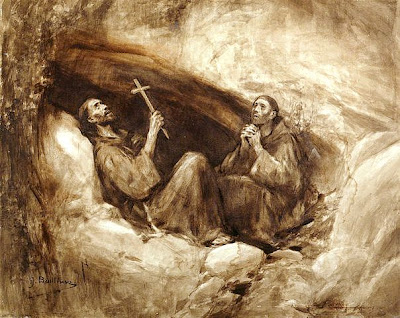





















The term you’re calling “homosexual love” in reference to St. Francis’ unnamed friend was simply the everyday word for friendship or affection in the original language. Anyone familiar with medieval texts knows that “love” was used freely—without any romantic meaning attached. Suggesting otherwise, especially when this friend isn’t even named or described, is just speculation.
On the topic of St. Francis and lepers: people avoided lepers out of fear of disease, not because of sexual morality. St. Francis’ compassion toward lepers was about human dignity and kindness, not approval of sexual behavior. Comforting the outcast does not equal endorsing sin.
Well done!
In the original language, the term you’re interpreting as “homosexual love” for St. Francis’ unnamed friend was just the standard term used for any friendship (or any degree of affection whatsoever). This is well known to anyone who has studied the medieval period, when the word for “love” was used constantly in practically every situation. It doesn’t imply romance, and the fact that his friend is unnamed and unknown does not justify making up fiction about him. Re: St. Francis’ treatment of lepers and its alleged connection to justifying sodomy: lepers were shunned by society because of the possibility of contracting the disease, which does not have any relevance to issues of sexual morality. Attempting to comfort lepers does not mean that St. Francis would approve of sexual sin.
Let us stop fighting the cause
that has already won it’s case
before God! Be for God
to Whom it matters not who one loves…
physic-ally in The Name of Love!
St. Francis knew. Rumi
knew, just as i do as I Am
one in our Trinity (appearing often to sum
as the divine circuits )
and no doubt would be like wise
in the centering with any
of the harlots of the dessert (sic).
The all-female Trinity fits with the Norns or the ‘Maiden, Mother, Crone’ trope. I have long believed that Odin and the Christian God are one and the same.
Excelente publicacion.bendiciones
This article is ridiculous!
St. Francis didn’t cross enemy lines to go give the sultan a homosexual kiss.
He did so to convert the mohammadans to Christianity for their brutality.
The 3rd wave feminist who wrote this is a complete moron!
I absolutely LOVE St. Francis! I love and appreciate his way of life, and I would follow him all the way — love of God, first, and of all God’s creation, including animals. If Francis had special friendships with men, so be it. He was a genuine lover; how lucky another person would be – man or woman – to be so loved. Francis is our model for living “the Jesus’ Way.”
Hello! I love this website so much; I actually cited you a good bit in a website I just published (https://queerlychristian.wixsite.com/transchristianity)! Thank you for all your work gathering this information.
I was wondering if you could tell me the source for your comment that Francis “experienced a vision of an all-female Trinity, who in turn saluted him as ‘Lady Poverty,’ a title that he welcomed” — I love that! but I’m having trouble finding more info on his all-female Trinity on google…
Avery, I’m thrilled by your new website! It’s wonderful in both design and content. Your site is teaching me a lot, so I will definitely be returning often to learn more and telling others about it. I appreciate your care in crediting your sources, including the many links to Qspirit.
You are the second serious scholar who contacted me for the source of all-female Trinity witnessed by St. Francis. I started writing a short answer here as a comment, but in the process I made some exciting new discoveries. I also realized that this subversive info has been buried and is extremely hard to find. For these reasons it deserves a full article about it here at Q Spirit. I’m writing it now and I will let you know when it is posted — probably in the next few days.
What an excellent article–
One cannot help but embrace the earthy, sensual, eccentricity of Francis. He had this wonderful relationship with God, but he was not a theologian– he was a lover. He was a lover of Christ– and of life. We have seen him regarded as sort of a “holy hippie.” or “nature boy.” Dare one extend that to include an intimacy with nature and with human nature that includes sexuality? Why not!? Must we keep him as a plastic artifact, or a garden statue or centerpiece of a bird-bath– but turn away from the flesh and blood exotic– and yes, erotic, person? It’s fine to have St. Francis in the garden– but it’s also fine to let him wander down the garden path a bit and not only indulge but celebrate the sensual– touch, sunlight on the skin, a dip in the stream, cool breezes, and those “conversations”– both spoken and unspoken in that cave. Now that’s my kind of man-cave– That’s what I miss after the passing of my partner of 44 years– intimacy that included God and each other and the beauty and poignancy of life. Brother Sun, Sister Moon–light of Christ–
I connot see myself becoming a nun in a traditional female convent. But I believe I may have had a calling to become a “Brother” in a male religious order. As I have always been very much a tomboy, I greatly prefer the company of men and share their interests. My own brother became a Passionist monk in Chicago and I dearly wish I could have joined him there,